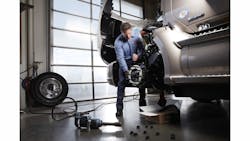Put the brakes on brake trouble
When commercial vehicle inspection officers conduct roadside inspections, almost half of the out-of-service violations they discover involve the brake system.
During Roadcheck 2014, of the out-of-service violations inspectors issued, nearly half of them – 46.2 percent – were for braking system and brake adjustment violations. This fact makes proper brake choice and maintenance critical for fleets to maximize uptime and maintain their safety ratings – thereby reducing their operating costs.
Sponsored by the Commercial Motor Vehicle Safety Alliance (CVSA), the annual 72-hour Roadcheck is the largest targeted enforcement program on commercial motor vehicles in the world.
Range of Issues
Our dealers see a variety of issues involving brake systems. Often, they find that the wrong choice of foundation brakes is among the root causes.
- Application. It’s vital that fleets start by choosing the right brake drums for their applications. For example, choosing 105-lb 16 1/2” by 7” replacement brake drums should provide adequate performance if your fleet runs Class 8 trucks that travel long distances. But if your trucks make frequent stops or travel to and from high mountainous areas often, a more heavy duty 112-lb brake drum should be used in order to deal adequately with brake fade.
- Weight. Truck operators may be tempted to equip their trucks with lighter drums to help shave weight or to save money. Choose too light of a brake drum and it may not be strong enough to resist the maximum mechanical stress caused by the expanding and self-energized brake shoes at high temperatures.
The brake drum acts as a heat sink. The heavier the brake drum, the more energy it will store, keeping all of that braking energy from wearing out the other braking parts faster.
But since many truck operators must be mindful of weight considerations, they should choose cast drums that are strong, but light, and are engineered and tested for the commercial truck market. Additionally, they should look for spring brake chambers that have heavy duty, synthetic rubber diaphragms that provide high resistance to abrasion and contaminants found in pressurized air.
Quality spring brake chambers will also have epoxy-coated steel power springs for longer life and greater corrosion resistance.
- Linings. Operators should also choose brake shoes with linings engineered and tested to meet the varied needs of their applications. By way of example, TRP offers brake shoes with three different grades of friction material for single and tandem axles in the 20,000-lb gross axle weight rating (GAWR) range.
Premium-grade friction material is engineered to handle high-braking duty cycles encountered in city pickup and delivery applications and where steep grades are also present. Standard-grade material is suited for on-highway, dry freight, intermodal, leasing and straight truck applications. Linehaul, or mid-grade material, is suited for medium duty, on-highway trailers, straight trucks and tractors.
Impact on other Components
Fleets looking to adopt air disc brakes should consider the impact those brakes can have on other components. More of the braking workload is transferred from the trailer to the tractor and the amount of torque in the front brakes increases.
This can increase the amount of torque the truck camshaft must handle. Therefore, operators of trucks equipped with air disc brakes should choose camshafts engineered to handle those higher torques.
Air Disc Brakes
While most fleets in Europe use air disc brakes on their trucks, a vast majority of fleets in the U.S. and Canada still equip their trucks with drum brakes. However, air disc brakes are gaining popularity because they last longer when properly spec’d and maintained. Plus, they take far less time to service than drum brakes.
Stopping distances are also greatly reduced since they exceed the federal government’s reduced stopping distance requirements.
Kenworth and Peterbilt have both made Bendix front air disc brakes standard on their Class 8 tractors and trucks. Both truck manufacturers offer Bendix front and rear air disc brakes as an option for select medium duty models.
Balance
Balance is one thing to keep in mind when choosing air disc brakes. Particularly if you want to choose air disc brakes for the steer position and drum brakes for the drive and trailer positions.
Some heavy haul applications with multi-axle trailers, super-Bs (two trailers linked together by a fifth wheel) and long combination vehicles will likely require air disc brakes on more than just the steer axle.
An air disc brake uses a metallic lining which sustains friction, allowing the brake to produce torque that generates heat up to 1,500 degrees F. Drum brakes, which use friction material typically made with high-temperature resins, produce torque with temperatures up to 600 degrees F before they fade.
Helpful Resource
The North American Standard Out-of-Service Criteria from the CVSA (https://cvsa.ps.membersuite.com/onlinestorefront/BrowseMerchandise.aspx) can help you develop preventive maintenance and driver inspection programs for brakes and other components. These programs, combined with the right choices in truck specifications and aftermarket replacement parts, can help you prevent unscheduled downtime and possible citations, fines and out-of-service violations.
